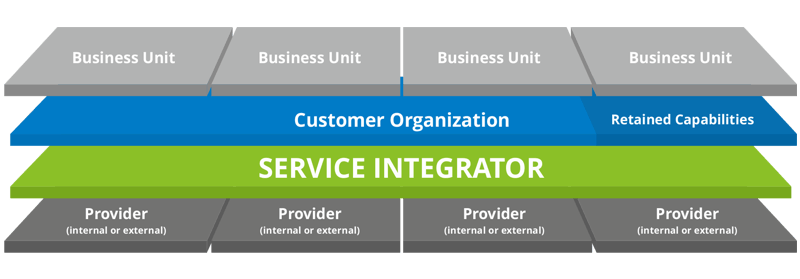The challenge
Digital change is taking place everywhere, and demands knowledge of many new technologies. The IT organisation of individual businesses, especially SMEs, often lacks the in-house expertise to realise all innovative ideas. Furthermore, it doesn’t always make sense to build up the expertise that would be needed to implement all these innovative ideas internally.
Instead, companies – especially in IT – tend towards dynamic procurement models. The aim is to obtain expertise as needed from service providers who have the desired skills.
Increasing demands are making IT organisation increasingly complex. Additional internal or external providers of services and products are constantly being added. Accordingly, maintaining an overview of the internal and external conditions of one’s own organisation entails extremely high levels of effort. Fast growth in the field of IT services and products does, however, also bring its advantages. Prices tend to fall, and new, innovative service providers arrive on the market.
More and more businesses are therefore critically examining the tools they use to implement innovative products and requirements seamlessly and – above all – promptly.
Because adaptability and the ability to innovate for one’s own IT organisation are of great strategic importance for businesses. In particular, the interaction of these two qualities is required.
This raises the following 2 key questions:
- How quickly can innovative processes and services be integrated in one’s own IT organisation efficiently and across providers
- How can an overview of all these internal and external service providers be guaranteed, as well as control over performance?
This is where SIAM comes into play!
What is SIAM?
SIAM means Service Integration And Management, and is a method used to manage different service providers and their integration. It introduces the concept of a service integration to create a single business-orientated IT organisation.
SIAM aims to integrate independent services from different internal and external providers in end-to-end services seamlessly. This leads to optimum performance from all service providers and therefore maximum and optimised added value for the client.
Using tools that support SIAM, new providers, services, and processes can be embedded into the business environment quickly and seamlessly.
Through the integration of ITIL (standardised workflows), service management processes can be implemented across various providers.
The SIAM system consists of 3 main levels:
- Client
- Service integrator (tool)
- Service provider (internal or external)

What does SIAM offer in terms of added value?
Correctly integrated SIAM helps organisations to manage their internal and external providers. Normally, this leads to the following optimisations, to name a few examples:
- improved resource utilisation
- lower costs for provision of the services
- Flexibility and scalability
- Agile implementation of new business requirements
- Improvement of service quality
- Risk reduction
- Improvement of client and user satisfaction
- Monitoring of provider quality and performance
- Reduction of duplication
In our next blog post, you can find out what the differences between SIAM and ITSM are.










